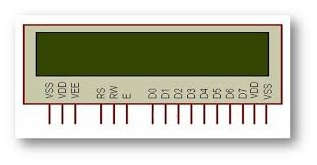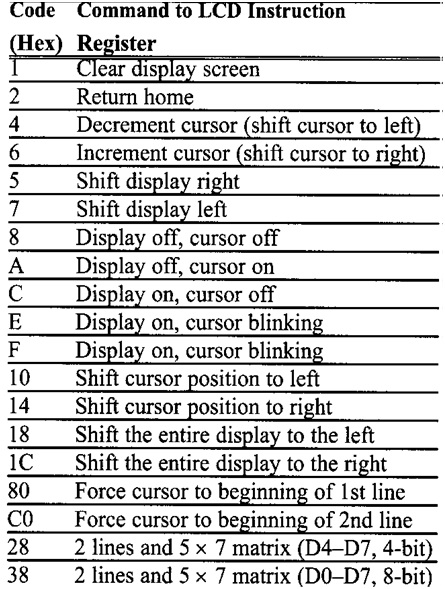寄存器和pin
In these years the LCD is finding widespread use. It has replaced the LEDs or other multi-segment LEDs.This is due to the following reasons:
近年来, LCD正在广泛使用。 它已替换LED或其他多段LED,原因如下:
The declining price of LCDs.
液晶显示器价格下降。
The ability to display numbers, characters and graphics. This is in contrast to LEDs which are limited to numbers and a few characters.
显示数字,字符和图形的能力。 这与限于数字和几个字符的LED形成对比。
Ease of programming of character and graphics.
易于对字符和图形进行编程。

Image source: http://electronica4u.blogspot.com/2012/03/how-16x2-alphanumeric-lcd-works.html
图片来源:http://electronica4u.blogspot.com/2012/03/how-16x2-alphanumeric-lcd-works.html
Image source: http://jinghanda.manufacturer.globalsources.com/si/6008801429542/pdtl/Alphanumeric-LCD/1035064002/Alphanumeric-LCD-Module.htm
图片来源:http://jinghanda.manufacturer.globalsources.com/si/6008801429542/pdtl/Alphanumeric-LCD/1035064002/Alphanumeric-LCD-Module.htm
LCD密码 (LCD PINs)
The LCD that we are discussing here in this section has 14 pins. The function of each Pin is given below:
我们在本节中讨论的LCD有14个引脚。 每个引脚的功能如下:
V cc ,V ss和V EE (Vcc, Vss and VEE)
Vcc and Vss provide +5V and ground to our LCD, respectively, VEE is used for controlling LCD contrast i.e. dimming the brightness or increasing the brightness of LCD.
V cc和V ss分别为我们的LCD提供+ 5V和接地,V EE用于控制LCD对比度,即调暗亮度或增加LCD的亮度。
RS(寄存器选择) (RS (Register Select))
There are two very important registers inside the LCD. The RS pin is used for the selection of these registers. If RS=0, the instruction command code register is selected, which allows the user to send commands for the LCD such as clear display, cursor at home, and so on. If RS=1, the data register is selected. It allows the user to send data that is to be displayed on the LCD.
LCD内部有两个非常重要的寄存器。 RS引脚用于选择这些寄存器。 如果RS = 0 ,则选择指令命令代码寄存器,从而允许用户向LCD发送命令,例如清晰显示,光标在家等。 如果RS = 1 ,则选择数据寄存器。 它允许用户发送要在LCD上显示的数据。
读/写(R / W) (R/W (Read/Write))
R/W inputs allows the user to write information to the LCD or read information from it. R/W is set 0 while reading and R/W is set 1 when writing.
R / W输入允许用户将信息写入LCD或从LCD读取信息。 读时R / W设置为0 ,写时R / W设置为1 。
E(启用) (E (Enable))
The enable pin is used by the LCD to latch information presented to its data pins.
LCD使用使能引脚来锁存提供给其数据引脚的信息。
When data is supplied to the data pins, a high-to-low pulse must be applied to this pin in order for the LCD to latch in the data present at the data pins. This pulse must be a minimum of 450ns wide.
当数据提供给数据引脚时,必须向该引脚施加一个高到低脉冲,以便LCD锁存数据引脚上的数据。 此脉冲的宽度必须至少为450ns 。
D0-D7 (D0-D7)
The 8-bit datapins, D0-D7 are used to send information to the LCD or read the contents of the LCD’s internal Registers. We send the ASCII codes is sent to the LCD to display numbers and letters for the letter A-Z, a-z, and numbers 0-9 to these pins while masking RS=1.
8位数据引脚D0-D7用于将信息发送到LCD或读取LCD内部寄存器的内容。 我们将ASCII码发送到LCD,以在屏蔽RS = 1的同时向这些引脚显示字母AZ,az和数字0-9的数字和字母。
There are also instruction command codes that can be sent to the LCD to clear the display or force the cursor to the home position or blink the cursor.
也可以将指令命令代码发送到LCD,以清除显示内容或将光标强制到起始位置或使光标闪烁。
The next table here incudes all the instruction command codes. To interface LCD to the AVR we can use 4-bit mode and 8-bit mode. The 8-bit data interfacing is easier to program but uses 4 more pins.
下表中包含所有指令命令代码。 要将LCD连接到AVR,我们可以使用4位模式和8位模式。 8位数据接口更易于编程,但又使用了4个引脚。

翻译自: https://www.includehelp.com/embedded-system/pin-diagram-and-registers-of-16x2-lcd.aspx
寄存器和pin

)
:深拷贝与浅拷贝(Deep Copy and Shallow Copy))




)
方法与示例)






方法及示例)


方法与示例)
